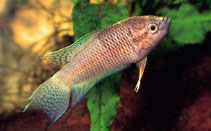| Family: |
Osphronemidae (Gouramies), subfamily: Macropodusinae |
| Max. size: |
5.76 cm SL (male/unsexed) |
| Environment: |
pelagic; freshwater; pH range: 6.5 - 7.80000019073486; dH range: 20 |
| Distribution: |
Asia: Viet Nam. |
| Diagnosis: |
Dorsal spines (total): 11-15; Dorsal soft rays (total): 4-9; Anal spines: 17; Anal soft rays: 11-14; Vertebrae: 28-30. Differs from its congeners by the following combination of characters: caudal fin forked; opercular spot pale or missing; body without dark bars or with 4-12 faint and inconspicuous dark bars on pale brown to dark greyish background in preserved and live specimens; top of head and predorsal body without dark spots or saddle-like blotches; posterior tip or margin of scales on head and body conspicuously darker than scales; distal part of first soft pelvic-fin ray red in life; spots and bars on dorsal and caudal-fin membranes black; posterior dorsal-fin membranes and caudal-fin membranes blue in life; filamentous caudal-fin rays with white or black posterior extremity (Ref. 42924). |
| Biology: |
Found in all kinds of hill stream habitats and along diverse structured margins or backwaters of large rivers, as well as in small streams and irrigation channels on farmland (Ref. 42924). |
| IUCN Red List Status: |
Data deficient (DD); Date assessed: 28 July 2010 Ref. (130435)
|
| Threat to humans: |
harmless |
Source and more info: www.fishbase.org. For personal, classroom, and other internal use only. Not for publication.

